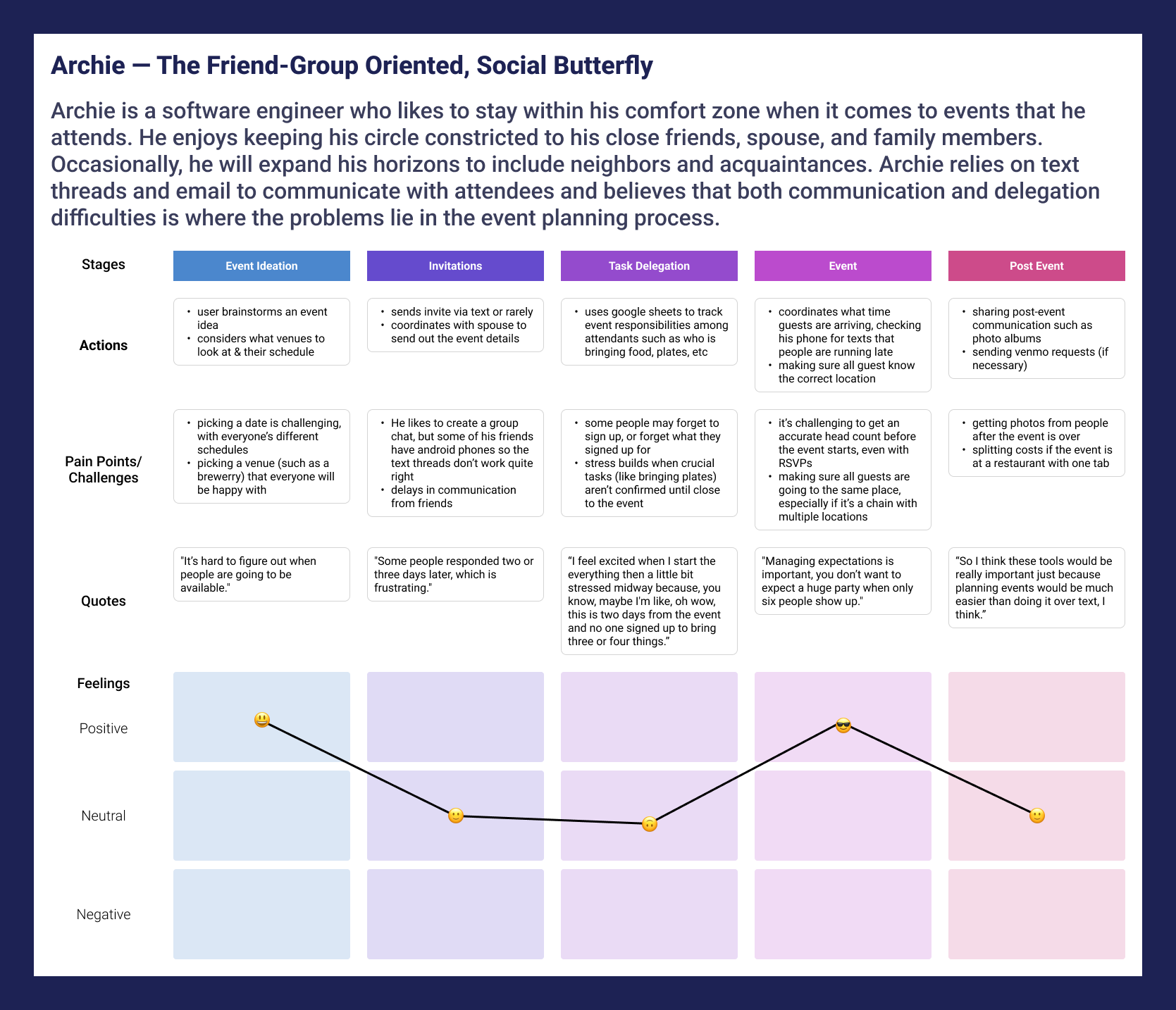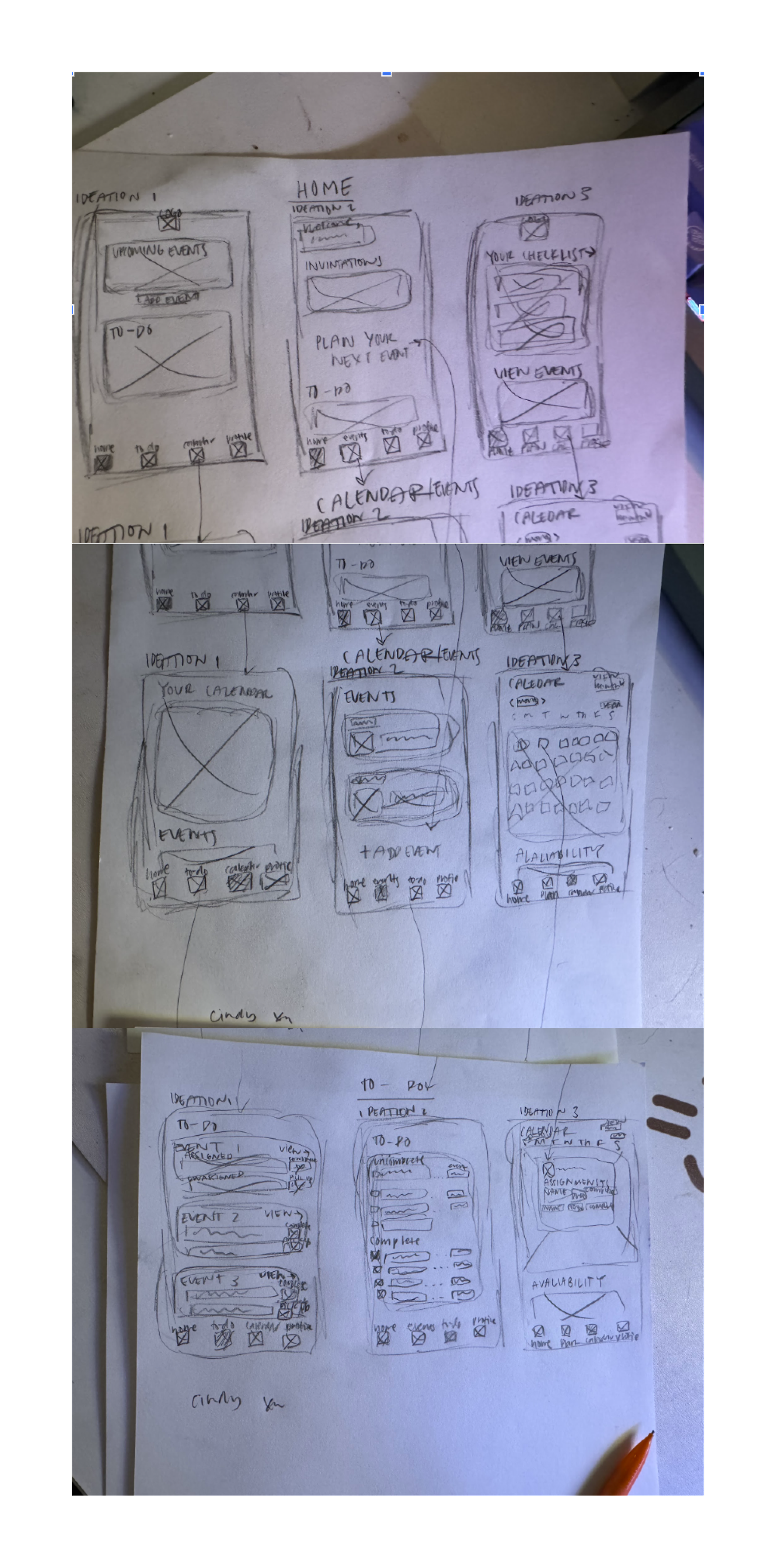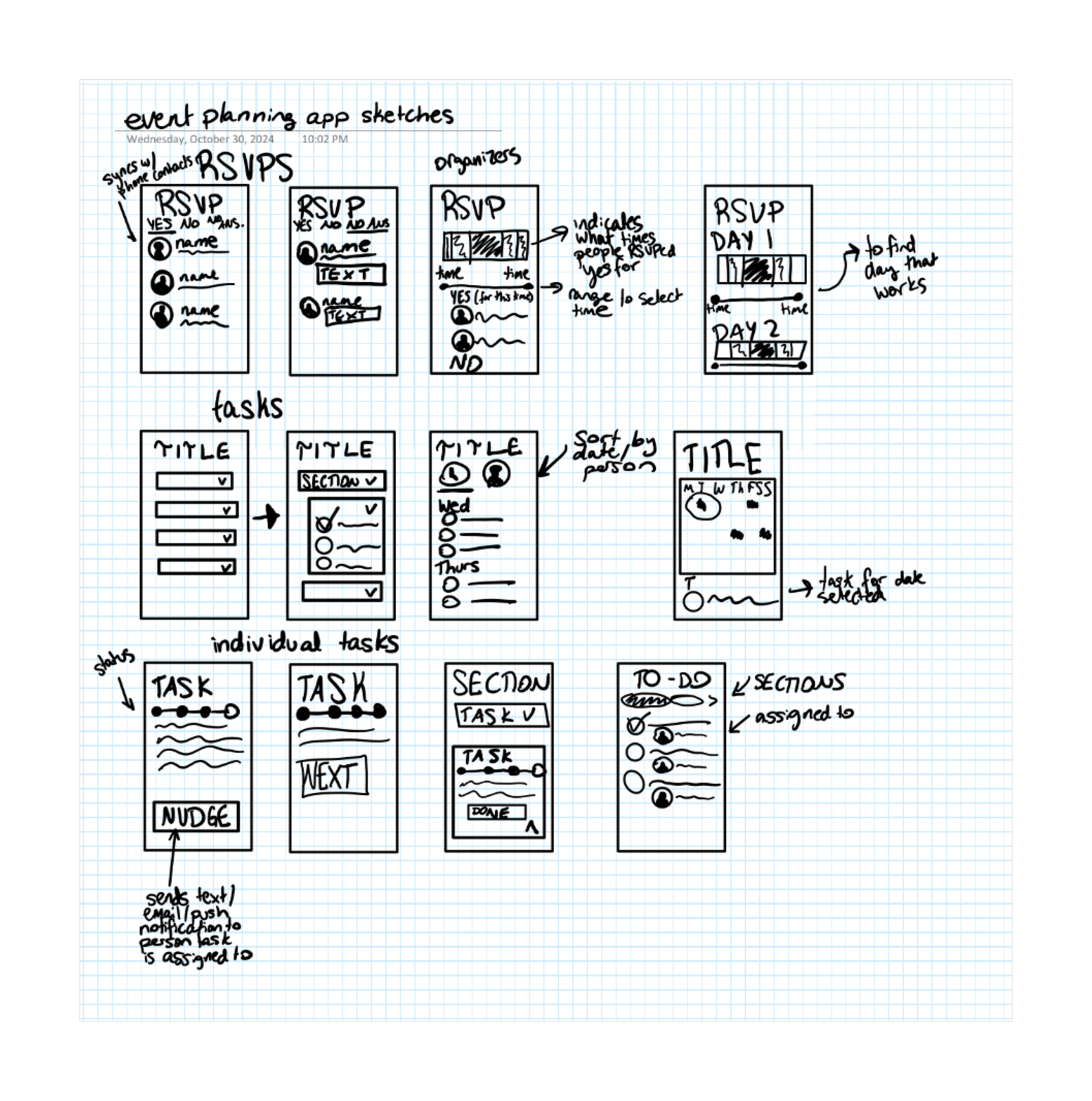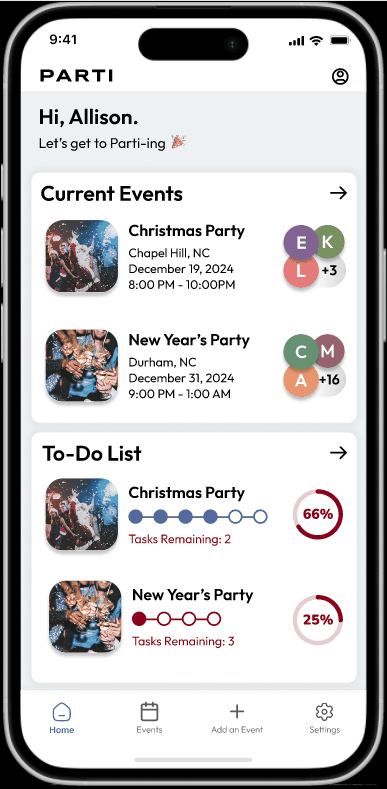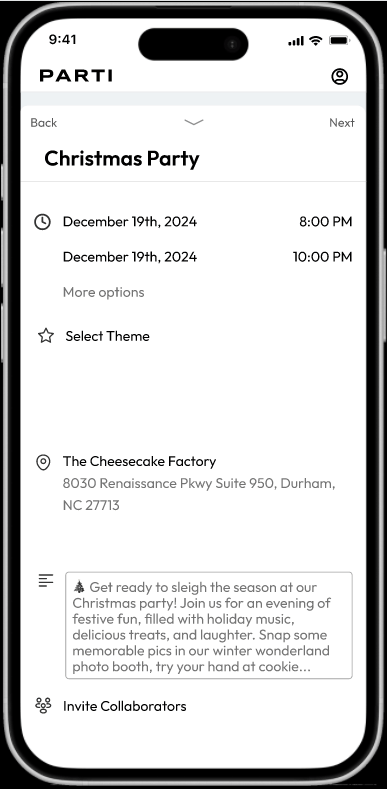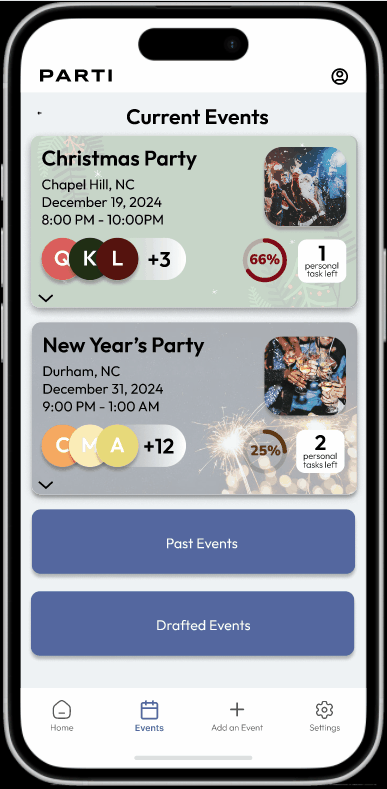Parti App Prototype
Mobile UI | End-To-End Design Process
Class Project - MEJO 581: UX Design and Usability @ UNC Chapel Hill
Iterated through the design-thinking process to address user pain-points with amateur event planning.
Project Overview
Over the course of a semester-long design thinking project, my team and I developed Parti, a conceptual mobile app designed to empower amateur event planners to organize gatherings with confidence and creativity. My team and I were tasked with identifying pain points with a given task, in which we chose event planning, and iterate through the design-thinking process in order to develop a prototype to address the identified pain points. We chose to focus on amateur event planning, in which users did not have formal tools to plan event suchs as family Thanksgiving dinner, club meetings, and after-work outings. The project followed the full design thinking process — from empathizing with users to prototyping and iterating on feedback — to create a tool that simplifies complex planning tasks while supporting collaboration and personalization.
We began by conducting user interviews to understand the common challenges and pain points faced by informal planners, such as planning transportation, coordinating with vendors, and tracking task completion and deadlines. These insights guided our design approach and helped us prioritize features that would be most valuable to users.
Through ideation and low-fidelity prototyping, we explored multiple interface concepts emphasizing usability and visual clarity. Usability testing sessions helped refine our design to feature customizable task lists, collaboration features, and event timeline visualization. The final high-fidelity prototype balanced aesthetics and functionality, providing a seamless experience for users at all planning stages. This project deepened my understanding of human-centered design, iterative prototyping, and user research synthesis. It also demonstrated the power of collaborative ideation in translating user insights into actionable design solutions that address real-world needs.
Role:
Interviewer, Usability Tester, Lead UI Designer
Team:
Cindy Xu
Mollie Mitchell
Ella Campbell
Anna Fetter
Timeframe:
Sept. 2024 - Dec. 2024
Our Problem Statement
Individuals planning events, such as family reunions or birthday parties, struggle with coordinating logistics, RSVPs, and activity schedules. How can we design a more intuitive event planning tool that simplifies the organization process for events that emphasizes the need for organized collaboration?
I: Develop a Research Plan
To develop our initial research plan, we needed to define our primary goal, identify key questions, and establish our target audience. We also laid out our research timeline, and ideated expected outcomes while identifying future steps after the research plan was completed.
Primary Goal
To understand specific challenges people face when planning gatherings of groups with six or more individuals.
What tools and methods do you currently use to manage and plan gathering logistics?
What are the main problems and frustrations in the gathering planning process?
What specific features do you wish existed in planning gatherings?
Target Audience
Methodology
Key Questions
Research Method: Remote survey / structured questionnaire
Number of Participants: 4-6
Interview Duration: 10-25 minutes
Tools: www.usertesting.com
Expected Outcomes
Age: 18-40 years old
Event Attendance: At least 3-5 times a year.
Event Planning: Email chains, group chats on messaging apps, Google Drive, word of mouth.
Timeline
Week 1 | September 24 - October 1
Finalize Research Plan and Interview Script
Make usertesting quiz, open for participants
Finalize Timeline of Deliverables in the Research Stage
Week 2 | October 2 - October 7
Go over interview scripts by Thursday, October 3rd
Analyze findings, pull out key pain points and present by Thursday October 7th
Insights into Current Practices: We will learn which technologies are our target event planners (socially active 18-40 year olds) use to plan their social gatherings of 6 or more. How do they usually go about planning events?
Pain Points: We will learn what the hardest point of planning events is for our users. We will likely hear about different types of events and the pain points for each. This will help us uncover overlap.
Feature Wishlist: Users will tell us the features they wished they had when planning events.
Refined problem statement: We will be able to focus our problem statement based on user feedback to narrow the scope of features that are necessary for us to build.
II: Analyze and Empathize
After completeing our interviews, we pulled out key details about our participants such as demographics, event planning needs, and event planning pain points. We seperated our findings into minor pain points, major pain points, and positive findings in order to familiarize ourselves with our participants’ feelings with event planning. After analyzing our findings, we concluded that there was a need for a centralized event planning tool to address our participants’ needs. Our findings led us to revise our original problem statement in order to best represent our participants feelings.
Minor Pain Points
Disorganized communication
Transportation issues
Task completion
Findings
Major Pain Points
Communication issues
Event management challenges
Logistics and planning
Conclusions
Positives Aspects
Helpful tools
Collaborative work environment
Communication efforts were not reciprocated
Trouble with vendor management (catering, rentals, transportation)
Issues delegating responsibilities
Revised Problem Statement
How can we create a more methodical event planning tool that enhances group communication and clarifies individual responsibilities, while promoting organized collaboration?
User Personas and Journey Maps
We then synthesized our findings to create three detailed user personas and journey maps in order to emaphize with and understand the users we were designing for.
III: Ideate with Lo-Fi Wireframes
Ideating with low-fidelity wireframes allowed us to rapidly brainstorm initial ideas and functions without getting bogged down by design details. It helped us focus on the core concepts we wanted to address in our design and quickly create creative design solutions to our user’s pain points. From these lo-fi wireframes, we as a group decided on which functions we found the most interesting to implement into our high-fidelity prototype.
IV: Prototype
It was time to design our first iteration of our high-fidelity partial prototype. This meant defining tasks for our potential users and designing for those specific tasks. Our team used Figma to create the wireframes, in which I took on the role of Lead UI Designer, creating a large majority of the wireframes using best design practices as well as establishing a theme and checking for cohesiveness of the wireframes.
Task 2: Sending Invites
Task 3: Events Dashboard
Task 1: Creating an event
V: Conduct Usability Tests
Once our initial prototype wireframes were complete, we conducted a moderated usability test with users in our target group, following a think-aloud protocol while observing our users complete our task flows. This included drafting an interview script where we defined our research goals for our testing. Once the usability tests were complete, we followed up with open-ended interview questions regarding our users’ experience with our prototype. Through this, we were able to identify our users’ likes and dislikes with our initial prototype to guide our redesign process.
Research Goals
Assess Ease of Use
Test Task Completion
Evaluate User Satisfaction
Uncover Navigation and Information Architecture Issues
Identify Accessibility Issues
Validate Design Consistency
Gather Insights for Future Design
Participants
P1: Graduate Student, 23 y.o.
P2: Undergraduate Student, 21 y.o.
P3: Stay-At-Home Mom, 48 y.o.
P4: Undergraduate Student, 19 y.o.
VI: Evaluate and Revise
Based on our user testing, we identified key problems and well as positive feedback with our initial prototype. From these problems, we seperated them into major and minor problems based on the frequency an issue was brought up as well as whether or not the issues that arose directly affected the usability of our interface and impeded user function.
Minor Pain Points
Dropdown Interactions
RSVP Status
Major Pain Points
Complicated Inivte Process
Back/Next Button Clarification
Theme Readability
Conclusions
Positives Aspects
Simple design
Syncing of contacts
Collaborative Functions
Overall, our users appreciated the ease of event creation and simplicity in navigation and design. The collaborative aspect stood out in a positive manner to users, and event details clarity was a positive that all users pointed out. However, there were issues with button clarity and invitation workflows.
Revisions
Based on our findings, we made redesign choices to implement in the new version of the prototype. Changes included reworking the invite process, as most of our users found that portion of the event creation processes non-intuitive. Furthermore, we decided to rethink our event themes, as it became an accessibility issue for users with impaired vision. Lastly, we looked to rework our buttons for better visbility and to clarify functionality for users.
Project Takeaway
Understanding users changed the project direction. Initial assumptions about how people plan events shifted after observing real user behaviors and pain points. Empathizing with users allowed us to redirect our problem statement to better suit user needs, driving functionality and leading to the design of meaningful features such as task progress bars and collaborative functions that improved user experience. Lastly, context matters. Design decisions that made sense in isolation didn’t always align with users’ real work environments or tools.







